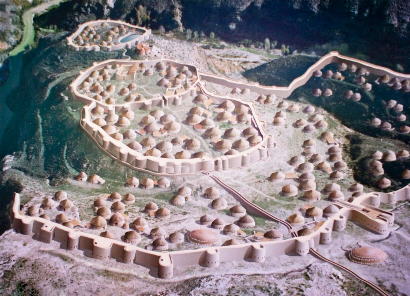++++++++++++++++++++++++++++++++++++
IBERIA CENTERED
++++++++++++++++++++++++++++++++++++

fortified Settlement of Los Millares in Granada
| LORDS OF THE EARTH 38 - THE DAWN OF CIVILIZATION | |
| Newsfax Turn: #12 ( 2075 - 2071 BC ) | |
| January 25, 2017 |
|
ATTACK ON ASSUR
2075 BC Lieutenant Aziru of Ugarit accompanied by feudal vassal Ilirapih march northeast into Edessa leading over six thousand troops. They are met by waiting guides who lead them east into Subartu itself. By late summer they are bivouacked near the encampment of a Subartun army of equal size commanded by the queen's son (and heir) Caregin and lieutenant Harun. 2074 BC The Levantine allies decide Caregin will be in overall strategic command. In the spring he leads the combined Subartan-Ugaritan force of over twelve thousand warriors (archers, mixed infantry and seige engineers) over the border into Mosul. Assuran king Ah-Kalla - already in the region - sends messages to his vassals to provide support; meanwhile he and lieutenant Shulpae organize the defense. The Assur homeland is protected by five stone forts. Mobile troops consist of four thousand mixed infantry supported by battle carts with another twelve hundred warriors armed as skirmishers. The Assurans have the benefits of defending in their own land whose flat terrain advantaged their fast-moving battle carts. The invaders are more numerous, have engineers trained to seige forts, spearmen for shock value and the tactical genius of Caregin. Meanwhile Tizar of Eshnunna and Ninazu of Arbiliq, both vassals of Assur, set out from their distant fiefs each bringing their household guardsmen which in combination total nearly two thousand. After manuvering for position, in summer comes the assault. Between them Subartu and Ugarit mass several thousand archers who cover the charge of their infantry with massed volleys of arrows, inflicting over five hundred casualties on the men of Assur before the armies close. Once the Levantine soldiers hit the Assuran lines the fighting is intense and bloody. By the time night falls, the Subartans have taken two thousand casualties and the men of Ugarit nearly twenty-three hundred; the defenders have endured over four thousand, smashed battle carts litter the area and one of the forts has largely collapsed. Taking stock during the night Al-Kalla realizes he is running out of men and facing defeat; he resolves to go down fighting. With the coming of dawn fighting resumes. The remaining Assuran infantry and battle cart riders are cut down - although not before Ugarit leader Aziru is wounded by a thrown javelin - and the forts' walls are undermined one by one. The impact of a fleeing wounded onager leaves the King of Assur stunned and he is taken prisoner. The Assuran camp is overrun and hundreds of wounded captured cursing their city's patron god Ashur for apparently abandoning them. While the allies are consolidating their hold on Mosul, Tizar of Eshnunna and Ninazu of Arbiliq cross the Tigris into Assur itself, joining Queen Bau and the city's small garrison. They learn of Al-Kalla's defeat and capture. 2073 BC The armies of Subartu and Ugarit close on Assur in the early spring. Queen Bau has few swords with which to defend the city, and even fewer when Ninazu of Arbiliq is slain in a duel and his household troops leave the city to return home with his body. Tizar of Eshnunna advises Queen Bau to negotiate to spare the city; she surrenders with the agreement there will be no sack. The Levantines keep their word and appoint Bau as satrap of an Assur now tributary to Subartu. Tizar and his men are paroled and leave for Eshnunna. Lieutenant Harun is appointed commander of the Mosul garrison. Everyone else heads back to Subartu; the men of Ugarit continue on until they reach home in the autumn. 2071 BC Nearly 60 and long troubled by his inability to save his King, Tizar of Eshnunna dies in his sleep. . |